Choosing Your Style: High Contrast vs. Low Contrast Hair Colors

Key Takeaways
**Think of contrast as the shade difference in your hair**, and select from high, medium or low to complement your style aspirations. Add highlights, lowlights, color blocks or hair painting for a bold statement or natural blend.
💫 Discover Your Complete Color Palette
Ready to discover all the colors that make you look radiant? Our comprehensive color analysis will reveal your complete personal palette - perfect for hair, makeup, and wardrobe decisions.
Take Color Analysis Quiz →Choose high or low contrast depending on the effect you want to achieve and your skin's undertone. Try pairings with a color wheel and a stylist to chart shades that compliment your features.
Color strategically to create contrast that shapes perception of lightness and depth around your face! Experiment with face-framing pieces or root shadows to emphasize eyes, cheekbones, or jawline without overpowering your style.
Go beyond light v dark by mixing warm and cool tones or surprising hues for artistic effect. Start out with tips or panels before making a full on commitment to high-contrast placements.
Blend technique to your hair texture and lifestyle for best results. Go for seamless balayage for curls and softer looks or foils and color blocking for sharp lines on straight hair.
Schedule a realistic hair routine to maintain your contrast. Plan salon touch-ups, sulfate-free care, bond repair and UV protection, and fading monitoring to fine-tune toners and glosses.
Contrast hair color adds dimension by combining light and dark hues to outline the face and enhance structure. Whether they opt for high and low lights, color blocking or bold streaks, stylists space lifts one – two cm apart for a crisp edge or blend for a soft shift to lift dimension.
Skin undertone guides shade picks: cool suits ash or icy, warm fits caramel or copper. To maintain health, use bond builders and gentle shampoos.
AHEAD, DEFINITIVE STEPS, TONE CHARTS, AND MAINTENANCE TIPS.
📚 Recent Articles
What is contrast hair color?
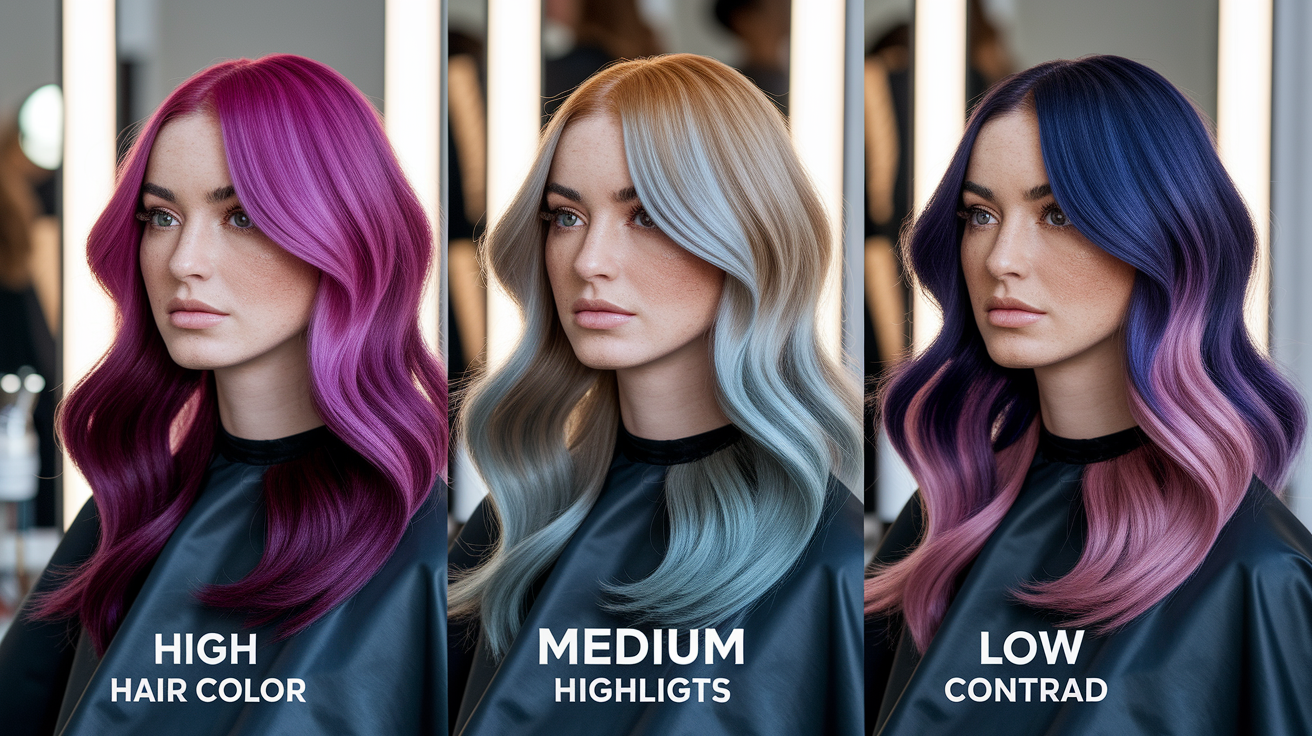
It feels like the contrast between light and dark, warm and cool, or muted and vivid–in hair and against skin and eyes. High, medium or low contrast hair color levels form harmony and effect. You can create contrast through color blocking, highlights and lowlights or expert hair painting. With a solid understanding of contrast you can create a standout style or a gently natural drift.
1. The core principle
Consider contrast to be a distinct change in lightness, darkness, or color, between sections of hair. When two or more shades sit a distance from each other on that scale, the eye registers a clear edge; when they sit near, the eye sees a soft mixture.
Balance is at the heart of the technique. Push contrast for assertive edges or turn it down for fading subtlety. Your level selection determines if the style reads as dramatic, or softly smudged. The right contrast can frame eyes, lift skin tone and echo your style.
Individuals with dark hair, light skin and bright eyes frequently pull off high contrast, whereas those with similar values across features often glow in low medium contrast.
2. High versus low
**High contrast looks**, such as black with platinum or deep brown with striking copper, create a bold and distinctive appearance. In contrast, low contrast hair aesthetics maintain shades that are close together, producing a calm flow that enhances natural beauty. Each approach offers unique benefits, whether it's the boldness of high contrast or the seamless harmony of low contrast styles.
Choosing **hair colors** should reflect personal style while considering skin tone and overall look. Color analysis categorizes individuals into seasonal palettes; for instance, Winter typically embraces high contrast, while Summer favors low to medium contrast. This thoughtful approach allows for an effortless appearance that resonates with one's natural features.
Ultimately, the decision regarding hair aesthetics is influenced by several factors, including personal taste and desired psychological effects. By understanding the pronounced difference between high and low contrast, individuals can achieve a memorable impression that aligns with their persona.
3. The visual impact
High contrast demands attention quickly and lingers in memory. It defines edges, intensifies shine and can help eyes pop. Low contrast diminishes hard lines and seems effortless, nearly sun-fused.
Your specific level can highlight cheekbones or jawlines, or soften the entire face. It forms the way we interpret brightness, depth, and style vibe day to day.
4. Beyond light and dark
Contrast lives in undertones and vivid blends. Warm versus cool plays a role: ash brown with gold ribbons, blue-black with rose warmth, or sand blonde with smoky lowlights. Weird but fabulous combinations—lavender highlights on black hair, or teal slashes through brunette—give you angst without all the damage of bleaching.
It's not just color–saturation and placement change contrast as well. A few bright highlights can increase contrast, while gentle lowlights can reduce it. Face-framing pieces alter how light hits skin, which can either flatter or combat your features.
Some are born high contrast, some low; knowing your level helps you choose. Seasons help guide: Winter suits crisp, Spring clear, Summer muted, Autumn deep and warm.
High contrast hair decoded
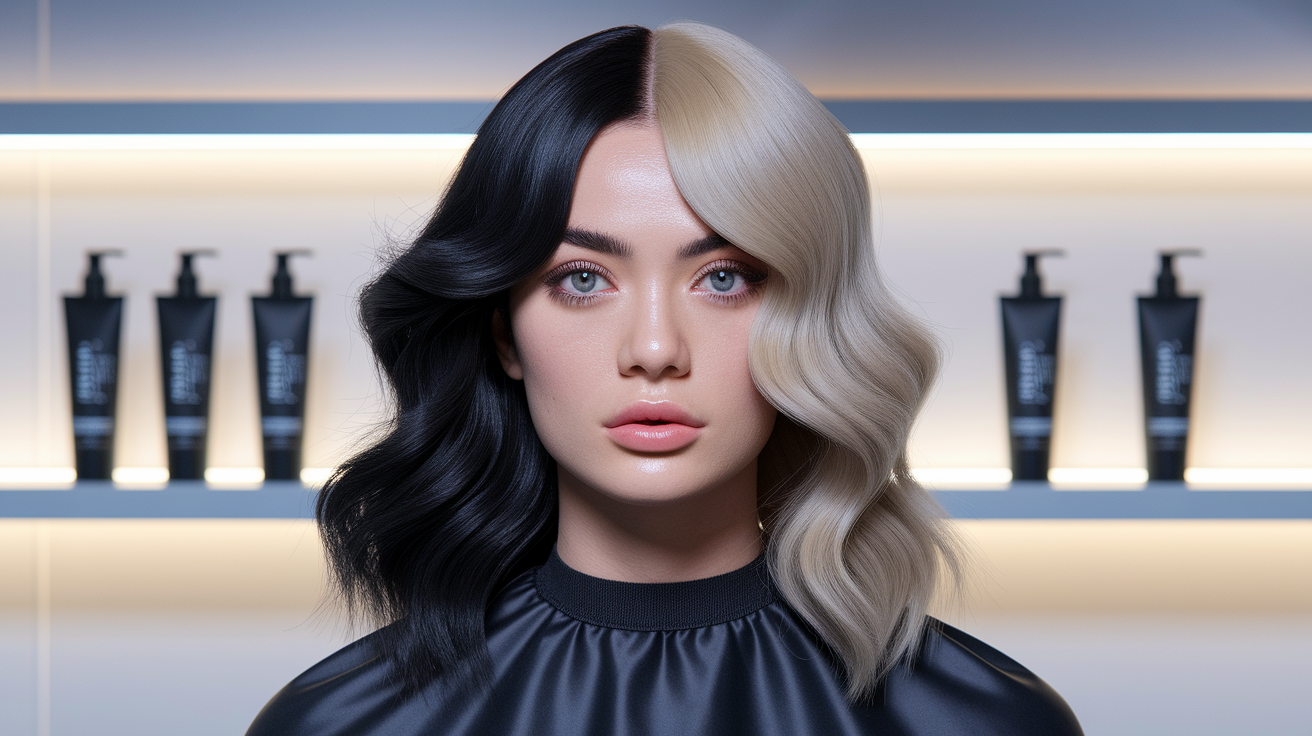
**High contrast hair** combines two or more shades with distinct differences in lightness, darkness or tone. The base color grounds the style, typically established either substantially darker or lighter than the highlights. This crisp divide results in a fresh, attention-grabbing look that plays contemporary, even at a distance.
Cool for those who want to live on the cutting edge and shines best with salon color blends for sharp demarcations, authentic saturation and gentler lift.
- Jet black base with pearl blonde face frame
- Dark brunette with icy silver ends
- Ash blonde with vivid cobalt panels
- Copper base with cool espresso lowlights
- Deep red with blush-pink money piece
- Charcoal gray with neon green streaks
- Warm brown with blue-black tips
High contrast hair de-mystified. Intense color tones require neutral accents—think creamy beige or espresso lowlights 2-3 shades darker—to prevent the eye from wandering. Placement is as important as pigment and a strategic design keeps things from being too overwhelming as the hair grows out.
The bold statement
High contrast hair grabs your eye intentionally. It's picked to pop, not blend in. Consider color blocking, split-dye halves, or dramatic shifts that transform the shape of the head into a component of the art.
Brunettes, blondes and redheads can all rock it. A high contrast hair decoded- a dark brunette might incorporate pearl blonde framing. A pale blonde can ground with smoke gray panels. A copper red can pop with espresso lowlights.
Match with makeup that pops too—sharp black liner or sculpted brow, or a red lip—to maintain the face's presence in the frame. These looks typically resonate most with those with innate contrast in their features–think bright eyes and pale or deep skin–but the concept scales. Some go for bold complements, others opt for softer, more harmonious pairs.
Modern techniques
Balayage, foils and express highlights top the list for creating contrast. Strategic painting can blur the edge for a melt, while tight foils seal in a hard line. High contrast hair, decoded.
- Foil work for crisp blocks or cash strips.
- Balayage for light-to-dark shifts that are seamless.
- Teasylights to blur lines but retain lift.
- Highlights to the rescue for fast face-lifting.
- Lowlights (2–3 shades darker) for depth.
- Root smudge to tame grow-out
Document your plan in a simple list: base shade, accent shade, placement map, maintenance cycle.
Ideal candidates
If you have built-in contrast—fair skin and dark eyes, deep skin with light eyes—you can likely wear high contrast hair with abandon. It compliments a lot of skin tones when hues resonate undertones and makeup complements the scheme.
Think warm browns with copper on warm skin, or cool ash with silver on cool skin. Think about the time and maintenance. High contrast roots grow out fast and show lines sooner, so schedule retouches every 6–8 weeks, or extend with root smudges and glosses.
Style, eyes, and daily dress count. Pick a wardrobe mood base, then one bold note you can live with on hectic days.
The subtlety of low contrast
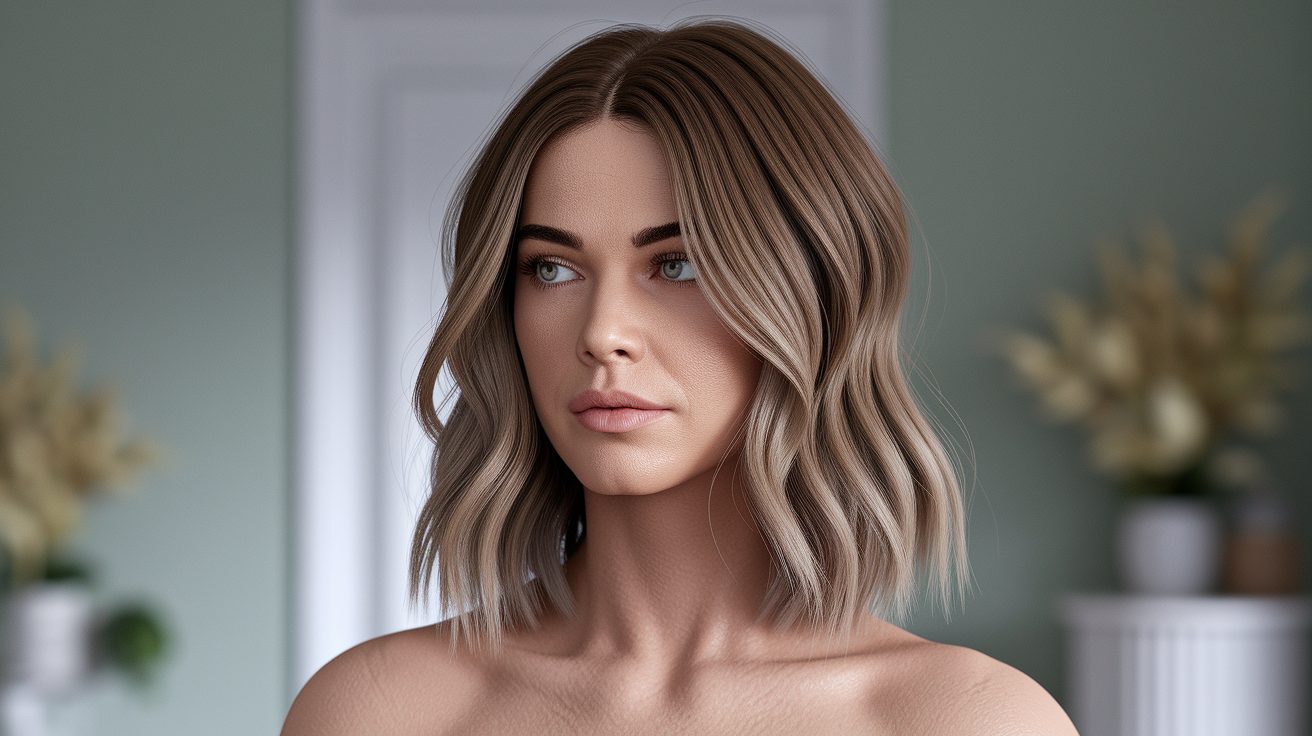
Low contrast hair employs the subtlety of slight shifts in shade and tone to appear soft, blended, and natural. Consider subtle contrast — usually 1-2 levels — between base and highlights, which is more of a medium-to-low part of the grayscale (approximately 5-6). Popular in browns, beiges and dusted colors, it flatters anyone seeking a subtle finish that grows out neat with minimal maintenance.
The appeal is daily wear: hair reads like your own, only brighter, softer, and easier to style. The effect reads lived-in from day one and doesn't compete with your features.
The blended look
A blended appearance exhibits gentle shifts between adjacent shades, such as chestnut to chocolate brown or sandy beige to mild taupe. There are no blunt stripes, no jagged discontinuities—only a gradual change that provides unobtrusive form.
Low-contrast balayage is most effective when painted strands fall a tone or two lighter than your natural foundation, so the light grazes movement without screaming. Low directionals or subtle low lights adding gentle depth, but its placement that counts.
- Chestnut base + cocoa lowlights
- Medium ash brown + mushroom beige ribbons
- Dark blonde base + sand and wheat whispers
- Soft black + espresso and dark mocha haze
- Beige blonde + oatmeal and pearl-beige veil
These combinations maintain low contrast and highlight the face.
Softening techniques
Smudgy espresso brown eyeliner and a nude lipstick go beautifully with low contrast hair, because they evoke the same tone-on-tone concept. Her face remains soft in low contrast, the eyes read clear without a hard frame.
For color, request delicate balayage or muted foils to deliver a subtle glow. Beigey tones and earthy shades–mushroom, oatmeal, taupe–keep the palette together and prevent brassy shifts.
Mix in both at the scalp and tips so your grow-out is smooth and upkeep remains easy. This method injects motion and illumination without appearing severe or too-formal.
Who it suits
Low contrast suits individuals whose hair, skin and eyes lie in comparable ranges. Think subtle shifts–like the harmonious style associated with Jennifer Aniston, where nothing competes.
It's good news for those who adore all-mono outfits or a serene, sophisticated closet. The hair plays second fiddle to the style, not the other way around.
Mature clients often choose it for convenience. The color fades out gently, helpful if salon visits are infrequent. Team with low-contrast makeup—diffused brows, neutral lids, sheer blush—for complete synergy and an effortless, polished vibe.
Your personal contrast guide
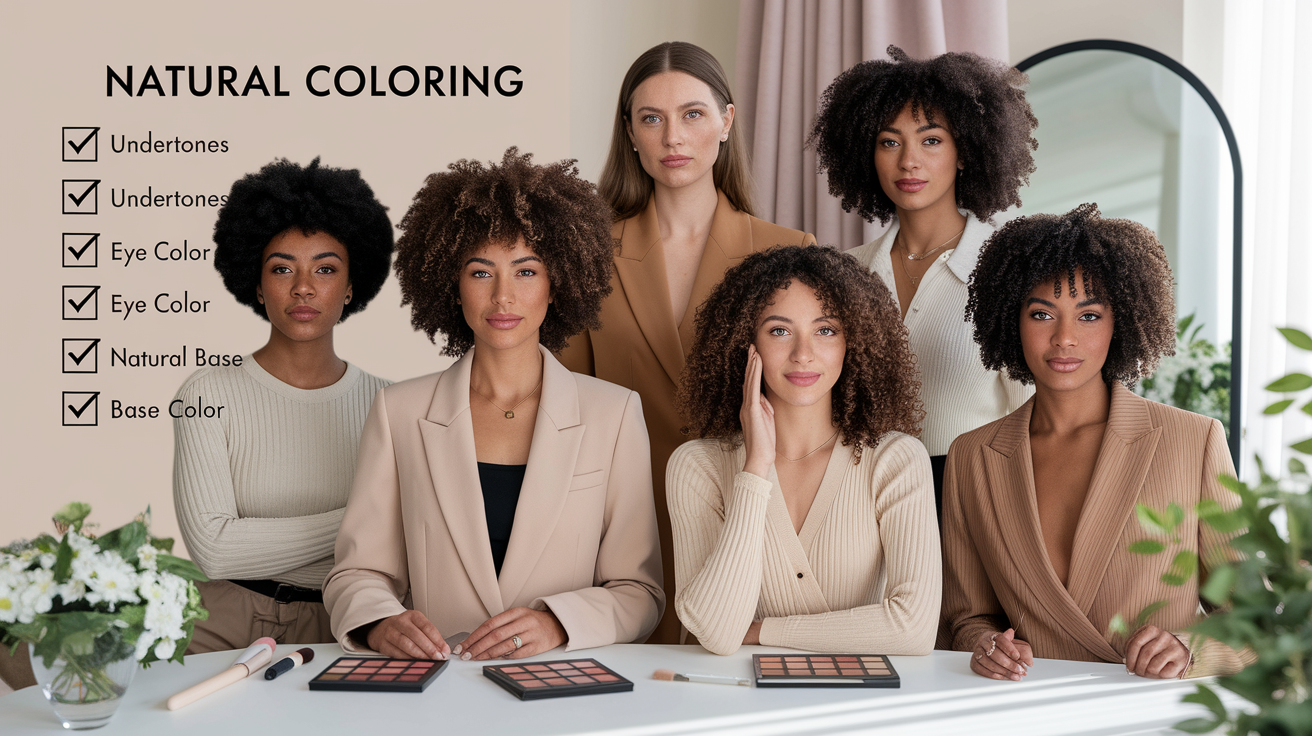
Begin by reading your **natural coloring** — hair, skin and eyes — in unison. Observe the brightness or darkness of each and the warmth or coolness of your undertones. Score the difference between features: 0–3 low contrast, 4–6 medium, 7+ high. Some of you sprawl in the crossover zone, so rule by day and shoot pics. Your **contrast level** dictates what color tricks and palettes appear balanced.
Make a checklist: undertone (warm, cool, neutral), eye color depth, natural base color, and how your wardrobe and makeup usually lean. Maintain balance by remaining 3–4 values apart in clothing and makeup.
Skin undertones
Determine your undertone. Warm (shows gold, peach or olive) Cool shows pink, red or blue. Neutral lurks in the center, that moves with light. Match shade temperature to undertone, then contrast.
Warm skin goes beautifully with golden black, espresso, chestnut, caramel, honey, copper or butterscotch. Cool skin works with ash brown, taupe, cool black, pearl blonde, icy beige, burgundy or plum. Neutral can take from both, but steer away from extremes that wash you out.
The appropriate amount of contrast can electrify your skin or tenderize shadows. Low contrast on fair-cool skin would employ pearl highlights 1 to 2 levels lighter than the base. On deep-warm skin, high contrast could employ inky roots with amber ribbons to pop.
For quick picks: warm undertones—golden blonde, warm brown, copper, bronze balayage; cool undertones—ashy blonde, cool brown, blue-black, raspberry; neutral—beige blonde, soft brown, mushroom brown, balanced bronde.
Hair texture
Texture alters the way contrast reads. Curls disperse light and merge edges, so intense colors appear gentler. Straight hair reveals more crisp lines and sharper transitions. Coils, of course, adore dimension, but fine straight strands can look streaky if the jump is too large.
Pick methods that accommodate motion. Waves such as low-contrast teasy lights. Coils glow with ribbon balayage. Pin-straight hair tames micro-foils or babylights for a smooth gradient.
| Texture | What it shows | Best contrast moves |
|---|---|---|
| Fine straight | Sharp lines | Babylights, micro-foils, 1–3 level shifts |
| Thick straight | Strong blocks | Soft ombré, smudge root, 2–4 levels |
| Wavy | Blended ribbons | Teasy lights, balayage, 2–5 levels |
| Curly/Coily | Diffused edges | Ribbon balayage, painted ends, 3–6 levels |
Document your texture notes with photos after styling.
Lifestyle fit
High contrast pulls rapidly on the eye. Roots appear earlier. Schedule touch-ups every 4–8 weeks. Low contrast merges and can extend to 10–14 weeks, or more.
Pair to your habits. If you heat style every day, a brash melt can maintain. If you air-dry and run, a soft, medium contrast with lived-in roots saves minutes.
Active lifestyles tend to prefer mix-and-match colors and tonal shifts instead of harsh lights. Discuss pricing, timing and upkeep with your stylist before you commit.
Facial features
Use contrast to direct attention. Face-framing pieces can accentuate and lift cheekbones, while deeper roots can provide more support to an ultra strong jaw. High contrast around the eyes draws your gaze to their irises and lashes while a softer gradient remediates lines.
Color by face shape. Round faces need the brighter line around the cheekbone to elongate. Squares mellow with scattered cash shards and submerged tips. Heart shapes appear balanced with dark at the crown and light through mid-lengths.
Sync with makeup. If your hair contrast is high, keep lips or eyes bold – not both. If it's low, lean on soft gradients—sheer tints, gentle contour. Try to keep outfit values within 3–4 steps of your hair-skin contrast for harmony.
The art of application
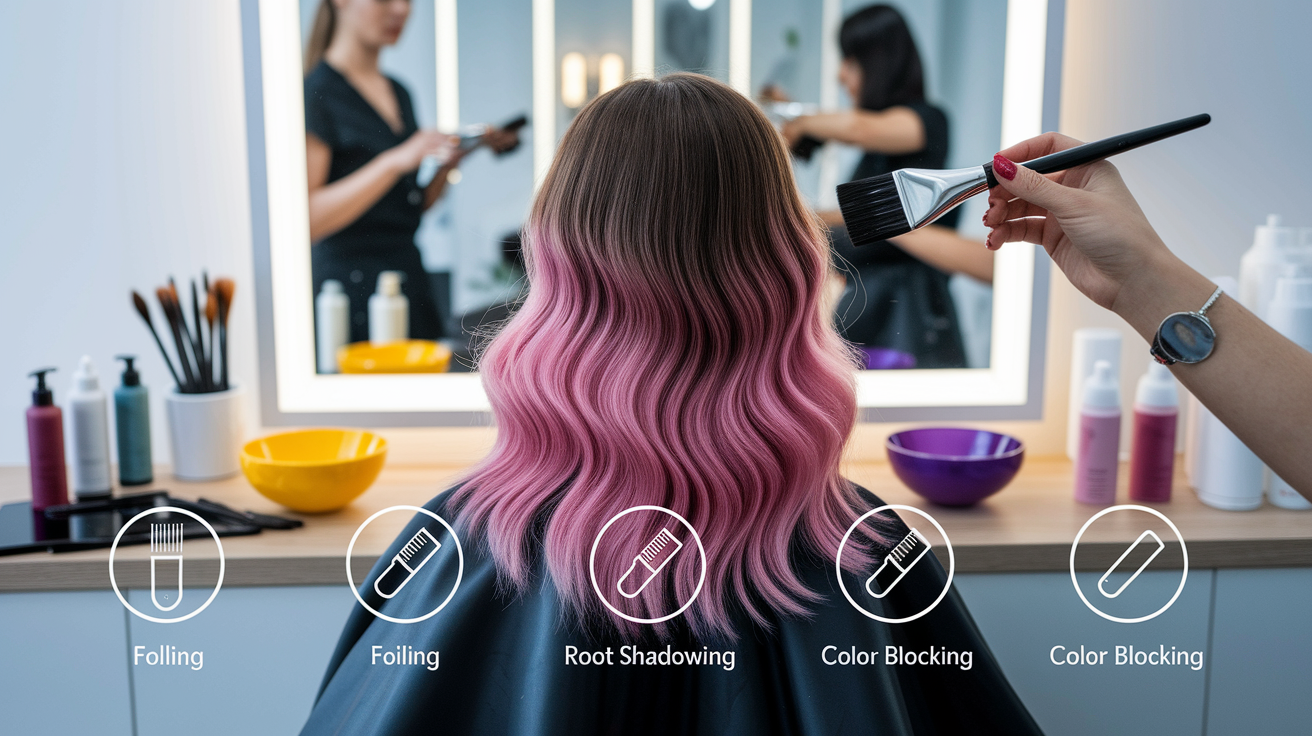
Expertise in contrast hair color is founded on ability, foresight, and care for hair integrity. Not just a fearless tint transformation, but even saturation, pure gloss and long-lasting impact. Techniques differ—balayage, foiling, root shadowing and color blocking—and can each drive contrast from subtle to dramatic.
Keep a pros and cons for each technique, maintenance notes, and map technique to hair's porosity, curl pattern, density, and previous color history.
Professional innovation
A master colorist combines cutting-edge formulas with precise application to maintain vibrancy while shielding hair. Using low-ammonia lighteners and bond builders, they can create high contrast looks that enhance an individual's natural beauty. Smooth transitions are achieved through calibrated timing, section size, and heat control, which reduces the risk of breakage and promotes an effortless appearance.
Salons specialize in tailoring contrast styles: subtle face-frame ribbons for a gentle shift or bold panels for a striking, graphic look. These contrast approaches allow for a seamless harmony between different shades, catering to the unique skin tone of each person. Consider innovative techniques like air-touch foiling for airy blends and micro-foils for crisp, high contrast.
For a distinctive appearance, balayage offers freehand flow and ombré gradients, while reverse balayage can enhance contrast without heavy lightening. Root shadowing softens lines, and color blocking creates memorable impressions with striking two-tone panels, showcasing the beauty of various hair aesthetics.
At-home risks
DIY lightener can lift too quickly at the roots while taking longer on the ends, which results in bands and patchiness, ultimately affecting your overall look. To achieve high contrast looks, be cautious with double bleaching on delicate strands, as this can increase the risk of breakage or shedding, especially for individuals with thin or previously lightened hair. Box kits often lack the salon depth and shine needed for a distinctive appearance, as their fixed pigment load and developer strength do not cater to your hair's unique porosity map.
When choosing hair colors, it's essential to build a personal risk checklist that considers several factors, such as your starting level, potential hot roots from scalp heat, and toner mismatches to your skin tone. A successful approach to hair aesthetics involves understanding the importance of bond care and aftercare to maintain the desired tone, ensuring a seamless harmony between your hair and natural beauty.
Ultimately, achieving a memorable impression requires attention to detail and an awareness of how different shades can create strong distinctions in your overall appearance. By considering your natural coloring and seasonal palette, you can make informed decisions that enhance your persona and reflect your personal style.
The color theory
Color theory guides contrast choices: hue (red, gold, ash), saturation (muted to vivid), and lightness (level) must fit the wearer's features and goals. Complementary pairs amp up contrast–cool ash highlights against warm brunette, or blue-black with copper ribbons–while analogous pairs maintain harmony, like honey, caramel and gold all in one clan.
The color wheel sets contrast and tonality. Warm v. Cool, icy v. Golden, all influence how skin and eyes interpret. Classic pairings by contrast: low—soft beige on dark blonde, espresso with cocoa; medium—chestnut with honey, ash brown with pearl; high—jet with silver, deep cocoa with pale sand, copper with dark violet for fashion tones.
Preserving your chosen contrast
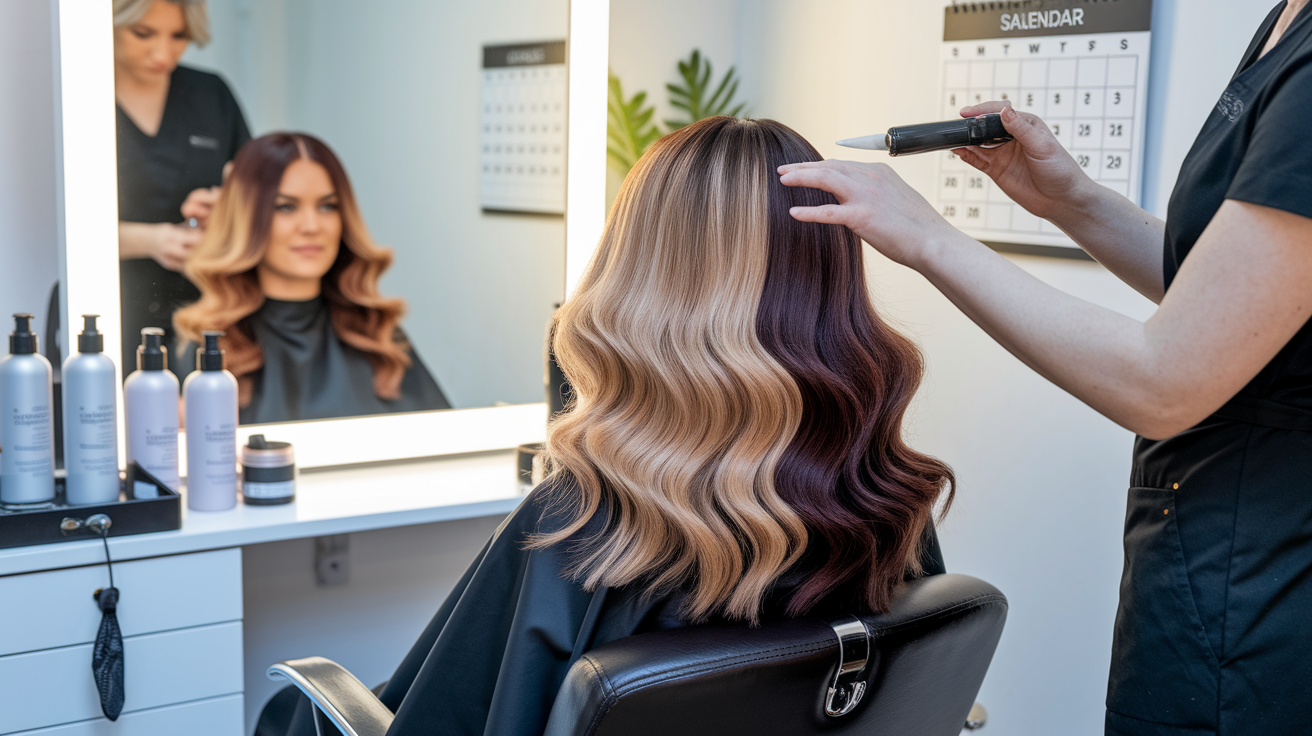
Maintaining high contrast hair aesthetics depends on habit, the proper supplies, and consistent scheduling. High-contrast looks fade faster, so toning and glossing are essential for achieving an effortless appearance that harmonizes with individual skin tone.
The maintenance reality
High contrast demands more from your schedule and your budget. Anticipate root touch-ups every 4–8 weeks, depending on growth and base shade. Schedule toner refills every 3-5 weeks to control brassy, plus glossing treatments to revive shine lost to lightening.
Create a maintenance calendar that records salon appointments, at-home toning and mask days. Low contrast is gentler with time, but non set-and-forget. A clear or tinted gloss every 6–8 weeks prevents soft blends from becoming flat.
Seasonal shifts matter too: warmer, richer tones often suit fall and winter; cooler, brighter shades fit spring and summer.
Checklist by contrast level:
- High contrast: blue/purple toner weekly, heat cap mask biweekly, UV shield daily, touch-up booking on a 6-week loop.
- Low contrast: gloss every 6–8 weeks, gentle wash routine, light leave-in, quarterly trim to keep ends neat.
Style notations help the lacquer linger. Those who wear "nude" beige pinks require their contrast matched or skin can appear flat. Dress with intent: high-contrast hair pairs well with crisp lights and darks. Low-contrast hair likes soft gradients and mid-tones.
Essential products
Sulfate-free shampoo to slow wash-out. Retain your blue shampoo for oranges and purples for yellows. Deep conditioners twice a week maintain fiber moist and reduce breakage from frequent lightening.
Spritz in a leave-in with heat and UV protection. This protects color on sunny days and beneath hot irons. A sheer oil seals ends without muting cool shades.
Salon-grade products extend the life of both high and low contrast, frequently due to pigments being balanced and conditioners contain bond builders. Must-haves: sulfate-free cleanser, hue-specific toner, hydrating mask, bond-repair treatment, UV/heat protectant, lightweight gloss or glaze, and a microfiber towel to cut friction.
Long-term effects
Repeated lightening can weaken the cuticle, dry hair out, and drain natural luster. Aftercare mitigates that risk and maintains your selected contrast punchy between appointments.
Rotate masks: one week for moisture, the next for protein or bond repair. If hair gets stingy, back off the protein and add slip. Monitor shifts with flash notes or snaps each month, so you can time toners, shift gloss tint, or lay in wash days.
Consider long-term balance. How to maintain your selected contrast? Your natural hair and skin color establish the minimum. Lush, dark tones may appear youthful, while muted, paler shades can introduce tranquility and a touch of sophistication.
Hair color is a statement of style and, for many, a personal statement. Save your rockstar by matching hair contrasting with clothes colors and skin tones — so the color of every article complements the rest.
Conclusion
To pick contrast hair color with confidence, complement shade to your complexion, brow density and eye color. High contrast gives crisp lines and strong contours. Low contrast appears soft and smooth. Both can be killer looking. Select what suits your energy and lifestyle.
Consider a dark espresso bob with light olive skin and dark eyes. Bright pop, quick style. Or a warm chestnut glaze on light brown hair and hazel eyes. Soft fade, effortless grow-out. Both work with a simple care plan: tone every 6–8 weeks, hydrate weekly, shield from sun, and use heat on low.
About to give it a whirl. Store two pictures illustrating your objective. Take them to your color pro. Or try gloss yourself and observe your reactions.
Frequently Asked Questions
What is contrast hair color?
Contrast hair color refers to how light or dark your hair is compared to your skin tone. High contrast equals dramatic division. Low contrast means softer blending. It informs whether your color should appear dramatic or subtle.
How do I know if I need high or low contrast?
Check your natural contrast for hair aesthetics. Contrast your hair, brows, and skin in sunlight; huge variances indicate that high contrast looks good on you, while minor differences suggest low contrast styles. This guides you in choosing hair colors that enhance your overall appearance.
What hair colors work for high contrast looks?
Aim for strong, defined shades that enhance your natural beauty. Consider bold color pairings like rich brunettes with vivid highlights or high contrast looks with platinum and dark roots, ensuring harmony with your skin tone.
What hair colors work for low contrast looks?
Opt for soft, blended tones to enhance your overall look. Choosing hair colors like balayage, soft highlights, and shades near your base color can create a seamless harmony that complements low contrast hair aesthetics.
How do I apply contrast without damage?
Work in passes to achieve a seamless harmony in your hair aesthetics. Opt for professional-grade products like BONDBUILDERS + TREATMENTS BOOKED, and consider choosing semi-permanent highlights or glosses to experiment with contrast styles.
How do I maintain my chosen contrast?
To maintain an effortless appearance and vibrant look, use color-safe shampoo and conditioner while incorporating weekly masks. Additionally, space out heat styling and refresh gloss or toner every 4–8 weeks to ensure strong distinctions in your overall appearance.
Can I adjust contrast with styling, not color?
Yes. Switch your part, add face-framing pieces, or root shadow sprays. Styling volume and makeup contrast (brows, lips) can either enhance your overall look or create a subtle transition, achieving a seamless harmony.